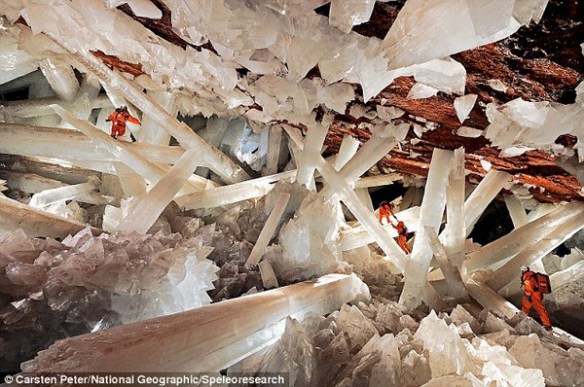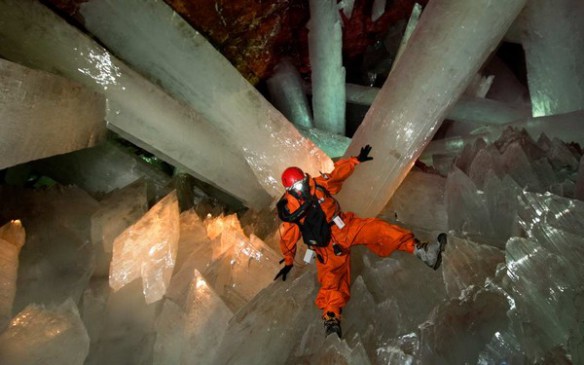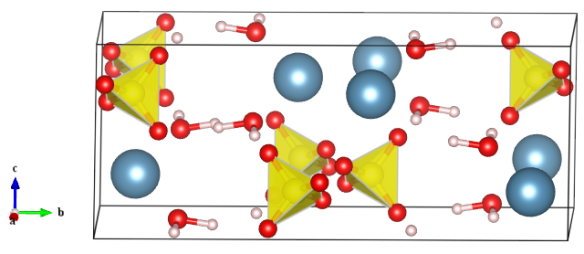Selenite – Crystal Cathedrals
What is it?
It is the dream of all crystallographers to develop a technique which can grow the largest and highest quality crystals possible. Often this is extremely difficult to do due to all of the competing factors which can drive crystal growth, and so it is often considered an art form. The rarity of large single crystals is what makes the Naica crystal caves truly extraordinary.

The great crystal cavern of Naica mines.
Buried 300 meters below the surface, and discovered at a time when people believed that they had seen every spectacular sight the earth had to offer, are the selenite crystal caves (Figure 1). No, this is not a carefully constructed Photoshop; those are real people climbing over pure gypsum crystals, otherwise known as selenite. In fact these are the largest of any naturally occurring crystals measuring up to 12 m in length, 4 m in diameter and 55 tons in weight. However, before you rush to pull out your passport and start booking flights, know that these caves are not open to the public. The caves are restricted partially for preservation purposes (instigated by a mining company of all things) but also because conditions within the cave are oppressive. Due to their location above an underground magma chamber and the presence of a large quantity of ground water, temperatures can sit at a constant 58 °C and 90 to 99 % humidity. Without special protection humans can only survive in these conditions for a few minutes. Incidentally, these are ideal conditions for crystal growth. Prior to their discovery, the caves were filled with hot, mineral rich water for 500,000 years. During this time the temperature hardly varied and the crystals were allowed to slowly grow to the size they are today.[1]

Researcher in protective gear among the crystals.
So if the caves are closed to public access, what are people doing there? A huge research project is being undertaken covering fields from medical research to regional geology. Some examples of the research being performed include: investigating how the crystals became so large and how old they are; studying pollen and microorganisms trapped inside the crystals; developing technology which enables humans to work in extreme conditions for long periods of time; and building an understanding of the physiological effects of exposure to these extreme conditions over a long period of time. However, the longer the crystals are exposed to the air the more faded and brittle they become, eventually cracking under their own weight. As a result there are constant discussions on whether research should continue in order to understand this unique natural resource or whether the caves should be re-flooded with water in order to preserve their current form.
What does it look like?

Structure was generated in VESTA.
As mentioned, the crystals are a pure form of gypsum known as selenite. The crystal structure of selenite/gypsum (CaSO4•2(H2O)) has been featured before on this site in its "desert rose form". The main difference between the desert rose crystals and selenite is the presence of sand impurities in desert rose. Another view of the structure is provided above, where calcium is shown in blue, SO4 tetrahedra are yellow, oxygen is red and hydrogen is white.
Where did the structure come from?
The image was generated from a structure in the paper Schofield P. F., Knight K. S., Stretton I. C. American Mineralogist 81 (1996) 847-851 and can be found in the American Mineralogist Crystal Structure Database.
Images from:
Cave of Crystal Giants – National Geographic Magazine, Available from: <http://ngm.nationalgeographic.com/2008/11/crystal-giants/shea-text> [November 2008]
[1] NAICA PROJECT/CRYSTALS’ CAVE, Available from: <http://www.naica.com.mx/english/internas/interna4_1.htm> [Accessed May 2014]






